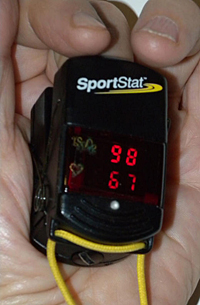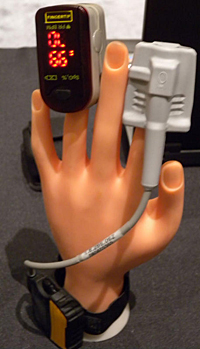An interesting device that has been around for a while as a complex and very large instrument in hospitals and emergency rooms is the blood oxygen saturation meter. A small fingertip version has been available for mountaineers and small plane pilots for a few years, but at a rather high price ($400-500 or more). But now several start-ups have appeared with models at a less exorbitant price (in the $200 and less ranges), with several companies exhibiting at the recent OR show.

The Nonin SportStat fingertip blood oxygen saturation meter.
While I do not expect to see every backpacker carrying one of these units in the near future, those of us with Wilderness First Aid (WFA) and Wilderness First Responder (WFR) training may want to add them to our field kits, particularly if we are with groups.
To use, these little meters are placed on a fingertip (usually the left hand) to give a continuous readout of pulse rate and blood oxygen saturation. Typically a healthy person has a resting pulse rate in the 50-75 beats per minute range (fit athletes at the low end) and a saturation in the high 90% range.
In the photo at right, I am using a Nonin SportStat, which indicates my oxygen saturation level of 98% (typical for sea level for healthy people) and a pulse of 67 beats per minute (I guess I was excited at taking the photo, since my waking pulse rate is typically around 47-51 bpm).
Exercise increases the pulse rate, but a high pulse rate or a very low one can indicate serious problems. Your oxygen saturation decreases with altitude, and with serious problems ranging from injuries to heart attack, stroke, and altitude sickness [especially High Altitude Pulmonary Edema (HAPE) and High Altitude Cerebral Edema (HACE)].
The new instruments are about twice the diameter of your thumb and the length of the first joint of your thumb. They weigh less than an ounce with the one or two AAA cells. Since they work by sending a beam of light through the thumb, the measurements are quite accurate and easier than searching for a pulse beat. A trained WFA or WFR knows that even with such an instrument, the feel of the pulse is also an important diagnostic.

MedChoice's MD300C2 fingertip unit.
An example of the new generation of "pulse-ox meters" at the show was shown by a company called MedChoice, based in Beijing. The photo at right shows two of their instruments, with the fingertip unit (MD300C2) on the finger of the dummy hand giving a reading of 99% oxygen saturation and pulse of 70 (this was a non-working display unit, normally the unit is read with the fingertips pointing toward the reader).
The other unit (MD300W, for the wrist) has the display on the part on the wrist. It also stores the pulse and oxygen information for later review, for example for an athlete or for analyzing sleep apnea (which happens at altitude for many people and is referred to as Cheyne-Stokes breathing).
Interestingly, when I tried one of MedChoice's working units, I had a blood oxygen saturation level of 97% and pulse of 69 bpm, pretty good for a sea-level dweller at the Salt Lake City altitude of about 4,500 feet MSL. Most people drop to about 90 to 95%, with a slightly elevated pulse until they have been in Salt Lake for a week or two.
A caution, though, for the user unfamiliar with what oxygen saturation means. Oxygen saturation is the percentage of your hemoglobin (in the red blood cells) that is saturated with oxygen, not a measure of the absolute of oxygen in your blood. It takes a while for your red cell count to build as part of the acclimatization process.
While these new units are unlikely to end up in the pack of every hiker and backpacker, they are worth consideration for the Wilderness First Responder, mountaineer, and leader of large groups.
Nonin offers the SportStat, FlightStat, and GO2 Achieve personal fingertip pulse oximeters.
MedChoice offers the Fingertip, Handheld, and Wrist pulse oximeters.

 by Bill Straka
by Bill Straka









